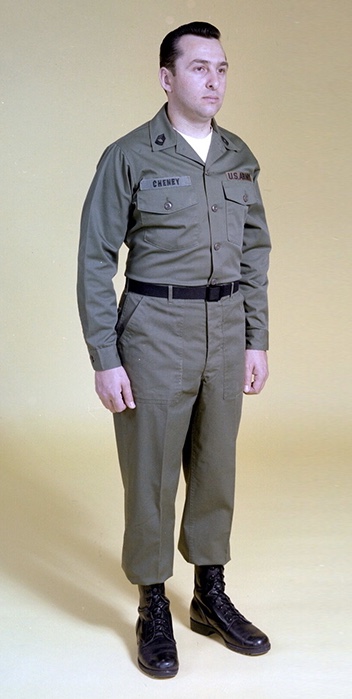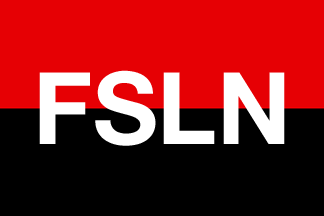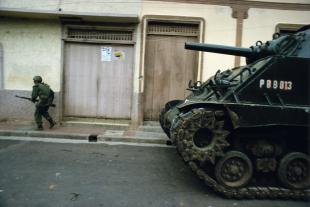|
OG 107
The OG-107 was the basic work utility uniform (fatigues) of all branches of the United States Armed Forces from 1952 until its discontinuation in 1989. The designation came from the U.S. Army's coloring code " Olive Green 107" and " Olive Green 507", which were shades of dark green, the OG-107 being cotton and OG-507 polyester-cotton blend introduced in the early 1970s. Regardless of the fabric, the two shades were almost identical. The OG-107 was superseded by the Battle Dress Uniform (BDU) throughout the 1980s, and was also used by several other countries, including ones that received military aid from the United States. All versions of the OG-107 shared several basic design features. They were made out of an 8.5 ounce cotton sateen. The shirt could be tucked in or worn outside the trousers depending on the preference of the local commander. If sufficiently hot and humid, troops could be permitted to roll up the sleeves and unblouse the trousers. It consisted of a button f ... [...More Info...] [...Related Items...] OR: [Wikipedia] [Google] [Baidu] |
Soldier Models Durable Press OG-507 Uniform, 1977
A soldier is a person who is a member of an army. A soldier can be a conscripted or volunteer enlisted person, a non-commissioned officer, or an officer. Etymology The word ''soldier'' derives from the Middle English word , from Old French or , meaning mercenary, from , meaning shilling's worth or wage, from or , shilling. The word is also related to the Medieval Latin , meaning soldier (literally, "one having pay"). These words ultimately derive from the Late Latin word , referring to an Ancient Roman coin used in the Byzantine Empire. Occupational designations In most armies use of the word "soldier" has taken on a more general meaning due to the increasing specialization of military occupations that require different areas of knowledge and skill-sets. As a result, "soldiers" are referred to by names or ranks which reflect an individual's military occupation specialty arm, service, or branch of military employment, their type of unit, or operational employment or technica ... [...More Info...] [...Related Items...] OR: [Wikipedia] [Google] [Baidu] |
US Military
The United States Armed Forces are the Military, military forces of the United States. The armed forces consists of six Military branch, service branches: the United States Army, Army, United States Marine Corps, Marine Corps, United States Navy, Navy, United States Air Force, Air Force, United States Space Force, Space Force, and United States Coast Guard, Coast Guard. The president of the United States is the Commander-in-Chief of the United States, commander-in-chief of the armed forces and forms military policy with the United States Department of Defense, Department of Defense (DoD) and United States Department of Homeland Security, Department of Homeland Security (DHS), both United States federal executive departments, federal executive departments, acting as the principal organs by which military policy is carried out. All six armed services are among the eight uniformed services of the United States. From their inception during the American Revolutionary War, the U.S. ... [...More Info...] [...Related Items...] OR: [Wikipedia] [Google] [Baidu] |
Royal Thai Armed Forces
The Royal Thai Armed Forces (RTARF) ( th, กองทัพไทย; ) are the armed forces of the Kingdom of Thailand. The nominal head of the Thai Armed Forces (จอมทัพไทย; ) is the King of Thailand. The armed forces are managed by the Ministry of Defense of Thailand, which is headed by the minister of defence and commanded by the Royal Thai Armed Forces Headquarters, which in turn is headed by the Chief of Defence Forces. The commander in chief of the Royal Thai Army is considered the most powerful position in the Thai Armed Forces. Royal Thai Armed Forces Day is celebrated on 18 January to commemorate the victory of King Naresuan the Great in battle against the Viceroy of Burma in 1593. Role The Royal Thai Armed Forces official role is the protection of the sovereignty and territorial integrity of the Kingdom of Thailand. The armed forces are also charged with the defence of the monarchy of Thailand against all threats, foreign and domestic. Apart f ... [...More Info...] [...Related Items...] OR: [Wikipedia] [Google] [Baidu] |
Thailand
Thailand ( ), historically known as Siam () and officially the Kingdom of Thailand, is a country in Southeast Asia, located at the centre of the Indochinese Peninsula, spanning , with a population of almost 70 million. The country is bordered to the north by Myanmar and Laos, to the east by Laos and Cambodia, to the south by the Gulf of Thailand and Malaysia, and to the west by the Andaman Sea and the extremity of Myanmar. Thailand also shares maritime borders with Vietnam to the southeast, and Indonesia and India to the southwest. Bangkok is the nation's capital and largest city. Tai peoples migrated from southwestern China to mainland Southeast Asia from the 11th century. Indianised kingdoms such as the Mon, Khmer Empire and Malay states ruled the region, competing with Thai states such as the Kingdoms of Ngoenyang, Sukhothai, Lan Na and Ayutthaya, which also rivalled each other. European contact began in 1511 with a Portuguese diplomatic mission to Ayutthaya, w ... [...More Info...] [...Related Items...] OR: [Wikipedia] [Google] [Baidu] |
Sandinista Popular Army
The Sandinista Popular Army (SPA) (or People's Army; , EPS) was the military forces established in 1979 by the new Sandinista government of Nicaragua to replace the Nicaraguan National Guard, following the overthrow of Anastasio Somoza Debayle. In post-Sandinista Nicaragua, the SPA was reformed into the National Army of Nicaragua. Joaquín Cuadra was named chief of staff, serving Defense Minister Humberto Ortega. A draft, called the Patriotic Military Service (), (SMP) was instituted in 1983. It later became Obligatory Military Service (Servicio Militar Obligatorio) (SMO). The special forces ''Tropas Pablo Ubeda'' initially came under the Ministry of Interior and then the BLI'S were Created. The SPA's ground forces formed the basis of what is now today the ''Nicaraguan Army Ground Forces'' (''Fuerzas Terrestres del Ejército de Nicaragua''), formed in 1995. They report directly to the Commanding General of the Army. History Sandinista Guerrilla Movement, 1961–79 The Sandani ... [...More Info...] [...Related Items...] OR: [Wikipedia] [Google] [Baidu] |
National Guard (Nicaragua)
The National Guard ( es, link=no, Guardia Nacional, otherwise known as ) was a militia and a gendarmerie created in 1925 during the occupation of Nicaragua by the United States. It became notorious for human rights abuses and corruption under the regime of the Somoza family (1936–1979). The National Guard was disbanded when the Sandinistas came to power in 1979. Creation Prior to the U.S. occupation, the long period of civil strife had encouraged the development of a variety of private armies. The freshly elected government of President Carlos José Solórzano requested that the U.S. Marines (equally interested in central control) remain in Nicaragua until an indigenous internal security force could be trained; for that effect, the Nicaraguan government hired in 1925 a retired U.S. General to help set up a new paramilitary gendarmerie force, titled the ''Guardia Nacional de Nicaragua'' (National Guard of Nicaragua).. That same year, U.S. forces left the country, but after a ... [...More Info...] [...Related Items...] OR: [Wikipedia] [Google] [Baidu] |
Lebanese Civil War
The Lebanese Civil War ( ar, الحرب الأهلية اللبنانية, translit=Al-Ḥarb al-Ahliyyah al-Libnāniyyah) was a multifaceted armed conflict that took place from 1975 to 1990. It resulted in an estimated 120,000 fatalities and an exodus of almost one million people from Lebanon. The diversity of the Lebanese population played a notable role in the lead-up to and during the conflict: Sunni Muslims and Christians comprised the majority in the coastal cities; Shia Muslims were primarily based in the south and the Beqaa Valley in the east; and Druze and Christians populated the country's mountainous areas. The Lebanese government had been run under the significant influence of elites within the Maronite Christian community. The link between politics and religion had been reinforced under the French Mandate from 1920 to 1943, and the country's parliamentary structure favoured a leading position for its Christian-majority population. However, the country had a ... [...More Info...] [...Related Items...] OR: [Wikipedia] [Google] [Baidu] |
Internal Security Forces
The Internal Security Forces Directorate ( ar, المديرية العامة لقوى الأمن الداخلي, al-Mudiriyya al-'aamma li-Qiwa al-Amn al-Dakhili; french: Forces de Sécurité Intérieure; abbreviated ISF) is the national police and security force of Lebanon. Modern police were established in Lebanon in 1861, with creation of the Gendarmerie. In April 2005, Ashraf Rifi became head of the ISF, replacing Ali Hajj. Rifi then started to recruit younger members to become part of Lebanese Intelligence. His term ended in April 2013, and he was replaced by Roger Salem, and Ibrahim Basbouss subsequently. On March 8, 2017, the Lebanese Cabinet appointed Imad Othman director-general of the ISF. He took command the following day. The number of personnel reached 30,000 people by 2000 and has grown to over 40,000 by 2013. The ISF National Day in Lebanon is on the 9th of June. Missions Their missions include : * Maintaining public order. * Highway patrol. * Counter-terroris ... [...More Info...] [...Related Items...] OR: [Wikipedia] [Google] [Baidu] |
Lebanese Armed Forces
) , founded = 1 August 1945 , current_form = 1991 , disbanded = , branches = Lebanese Ground ForcesLebanese Air Force Lebanese Navy , headquarters = Yarze, Lebanon , flying_hours = , website = , commander-in-chief = Vacant , commander-in-chief_title = Commander-in-chief , chief minister = Najib Mikati , chief minister_title = Prime Minister , minister = Maurice Sleem , minister_title = Minister of Defense , commander = Joseph Aoun , commander_title = Commander of the Armed Forces , age = 18–30 years of age for voluntary military service , conscription = No (abolished in 2007) , manpower_data = , manpower_age = 18–39 , available = 1,106,879 , available_f = 1,895,723 , fit = 934,828 , fit_f = 948,327 , reaching = , reaching_f = , active = 75,000 , ra ... [...More Info...] [...Related Items...] OR: [Wikipedia] [Google] [Baidu] |
Military Of Cuba
The Cuban Revolutionary Armed Forces ( es, Fuerzas Armadas Revolucionarias; FAR) are the military forces of Cuba. They include ground forces, naval forces, air and air defence forces, and other paramilitary bodies including the Territorial Troops Militia (''Milicias de Tropas Territoriales'' – MTT), Youth Labor Army (''Ejército Juvenil del Trabajo'' – EJT), and the Defense and Production Brigades (''Brigadas de Producción y Defensa'' – BPD), plus the Civil Defense Organization (''Defensa Civil de Cuba'' – DCC) and the National Reserves Institution (''Instituto Nacional de las Reservas Estatales'' – INRE). All these groups are subordinated to the ''Ministro de las Fuerzas Armadas Revolucionarias'' (" Ministry of the Revolutionary Armed Forces" – MINFAR). The armed forces have long been the most powerful institution in Cuba. The military manages many enterprises in key economic sectors representing about 4% of the Cuban economy. The military has also served as forme ... [...More Info...] [...Related Items...] OR: [Wikipedia] [Google] [Baidu] |
Cuban Revolution
The Cuban Revolution ( es, Revolución Cubana) was carried out after the 1952 Cuban coup d'état which placed Fulgencio Batista as head of state and the failed mass strike in opposition that followed. After failing to contest Batista in court, Fidel Castro organized an armed attack on the Cuban military's Moncada Barracks. The rebels were arrested and while in prison formed the 26th of July Movement. After gaining amnesty the M-26-7 rebels organized an expedition from Mexico on the Granma yacht to invade Cuba. In the following years the M-26-7 rebel army would slowly defeat the Cuban army in the countryside, while its urban wing would engage in sabotage and rebel army recruitment. Over time the originally critical and ambivalent Popular Socialist Party would come to support the 26th of July Movement in late 1958. By the time the rebels were to oust Batista the revolution was being driven by the Popular Socialist Party, 26th of July Movement, and the Directorio Revoluci ... [...More Info...] [...Related Items...] OR: [Wikipedia] [Google] [Baidu] |
Bolivian Soldier Armed With A FN FAL Stands Guard During Fuerzas Unidas Bolivia
Bolivian may refer to: * Something of, or related to Bolivia ** Bolivian people ** Demographics of Bolivia ** Culture of Bolivia * SS ''Bolivian'', a British-built standard cargo ship A cargo ship or freighter is a merchant ship that carries cargo, goods, and materials from one port to another. Thousands of cargo carriers ply the world's seas and oceans each year, handling the bulk of international trade. Cargo ships are usu ... {{disambig ... [...More Info...] [...Related Items...] OR: [Wikipedia] [Google] [Baidu] |






